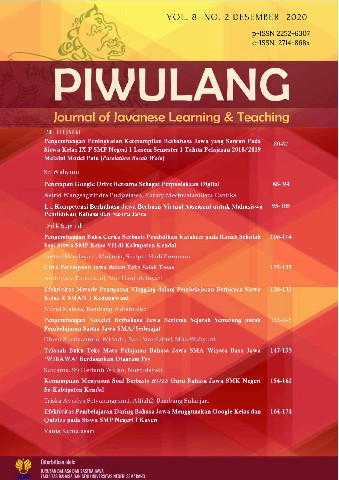Uji Kompetensi Berbahasa Jawa Berbasis Virtual Assessment untuk Mahasiswa Pendidikan Bahasa dan Sastra Jawa
##plugins.themes.academic_pro.article.main##
Abstract
Testing a competency requires thoroughness on the character of scientific studies. These
criteria are used as a benchmark for assessment which is realized in the form of a variety of
measuring instruments. The challenge is that the measuring instruments that are made still
contain learning elements, not just looking for the weaknesses and strengths of the test
takers. The design also needs an agreement between the organizer and the test takers, so
that the activities run comfortably. This makes the exam more functional, useful, and doesn't
waste anyone's time. This is the essence of learning. Developing a Javanese language
competency test tool like this needs to be realized. The method used is structured through a
virtual assessment approach. This approach contains (a) the concept of assessement, (b)
orientation of the assessement, (c) management assesement, (d) assessment of the
assessment, (e) analysis of the assessment, and (f) conclusion of the assessment. These six
things produce data about the quality of student competencies. A total of 100 multiple choice
questions are composed of 5 competency elements, namely (a) cultural science, (b)
linguistics, (c) literature, (d) education, and (e) writing scientific papers. Meanwhile, 4
essay questions contain their scientific work ideas. Questions are packaged with online
media. Conceptually, students' abilities have been identified. So in conclusion, a realistic
approach is still needed so that it is able to generate or even strengthen potentials that are
not recorded by written measuring instruments. This is a conclusion that contains
suggestions for clinical supervision for maximum results.
##plugins.themes.academic_pro.article.details##
References
Damayanti, Kartika Ayu. 2012. “Pengaruh Persepsi Mengenai Lingkungan Belajar dan Achievement Emotion terhadap Achievement Goal Siswa di SMAN 1 Taman Sidoarjo.†Artikel. Surabaya: Jurnal Psikologi Pendidikan dan Perkembangan.
Dwiraharjo, Maryono 1997. “Fungsi dan Bentuk Krama dalam Masyarakat Tutur Jawa Studi Kasus di Kotamadya Surakartaâ€. Disertasi. Yogyakarta: Universitas Gadjah Mada. (Unpublished).
Huda, Miftahul. 2013. Model-model Pengajaran dan Pembelajaran. Yogyakarta: Pustaka Pelajar.
Joyce, B., & Weil, M.1992. Models of Teaching. Englewood Cliffs, New Jersey: Prentice-Hall Inc,.
Kumirah. 2018. “Pengembangan Media Pembelajaran Berbasis Feature Vidio dalam Mata Pelajaran IPS Kelas VII SMP Negeri 2 Galur Tahun Pelajaran 2017/2018.†Tesis. Yogyakarta: Universitas Negeri Yogyakarta.
Loon, Harry Van. 1965. “A climatological Study of the Atmospheric Circulation in the Southern Hemisphere during the IGY, Part I: 1 July 1957–31 March 1958.†Article. American: Journal of Applied Moteorology and Climatology.
Mansilla, V.B. & Jackson, A. 2011. “Educating for Global Competence: Preparing Our Youth to Angage the Word.†Article. US State: Concil of Chief State School Officers’ EdStep Initiative and Asia Society Partnership for Global Learning.
Slavin, R.E. 1994. Educational Psychology: Theory and Pactice. Fourth Edition. Massachusetts: Allyn and Bacon.
Sukmadinata, Nana Syaodih. 2007. Metodologi Penelitian Pendidikan. Bandung : PT. Remaja Rosdakarya.
Suryadi, M., Subroto Edi, HD., Marmanto, Sri. 2014. “The Use of Krama Inggil (Javanese Language) in Family Domain at Semarang and Pekalongan Cities.†Article. Canadian: International Journal of Linguistics.
